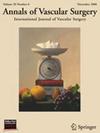Improving Depression Detection and Measuring Its Impact upon Short-Term Survival in Chronic Limb-Threatening Ischemia
IF 1.4
4区 医学
Q3 PERIPHERAL VASCULAR DISEASE
引用次数: 0
Abstract
Background
Depression is underdiagnosed in chronic limb-threatening ischemia (CLTI) patients, and its impact on outcomes is unclear. This study aims to evaluate a CLTI-specific questionnaire designed to detect depression and anxiety, as well as to quantify its impact on early outcomes.
Methods
A serial cross-sectional study was conducted over the following 2 4-month periods: block I, which retrospectively examined depression prevalence based on medical records, and block II, which prospectively assessed depression using a CLTI-specific questionnaire. Patients were followed for 6 months to assess early outcomes. Data on demographics; comorbidities; wound, ischemia, foot infection (WIfI) grades; perioperative and 6-month limb salvage; and survival were collected and analyzed.
Results
We evaluated 101 CLTI patients (58 in block I; 43 in block II; median age 68 years [interquartile range 62–74]; 67 [66.3%] male). In block I and block II, 20.7% and 23.3% (P = 0.76), respectively, had a prior depression diagnosis. The CLTI-specific questionnaire in block II showed a median depression score of 22 (interquartile range 19–33), identifying 32.6% with moderate/severe depression and 11.9% more patients compared to chart review alone. Active smoking (hazard ratio 5.16, 95% confidence interval 1.9–14.1) and WIfI clinical stage 4 (hazard ratio 4.69, 95% confidence interval 1.39–15.75) were significantly associated with depression. At 6 months, patients with depression had higher rates of major amputation (18.2% vs. 4.0%; P = 0.02) and mortality (27.3% vs. 6.3%; P < 0.01).
Conclusions
The overall prevalence of depression in CLTI patients is 32.6%. Our novel CLTI-specific questionnaire detects 12% more cases of moderate/severe depression compared to chart review alone. Depression was linked to higher 6-month mortality, though confounders like smoking and WIfI stage 4 may contribute. Identifying and treating depression in high-risk CLTI patients could improve outcomes.
求助全文
约1分钟内获得全文
求助全文
来源期刊
CiteScore
3.00
自引率
13.30%
发文量
603
审稿时长
50 days
期刊介绍:
Annals of Vascular Surgery, published eight times a year, invites original manuscripts reporting clinical and experimental work in vascular surgery for peer review. Articles may be submitted for the following sections of the journal:
Clinical Research (reports of clinical series, new drug or medical device trials)
Basic Science Research (new investigations, experimental work)
Case Reports (reports on a limited series of patients)
General Reviews (scholarly review of the existing literature on a relevant topic)
Developments in Endovascular and Endoscopic Surgery
Selected Techniques (technical maneuvers)
Historical Notes (interesting vignettes from the early days of vascular surgery)
Editorials/Correspondence

 求助内容:
求助内容: 应助结果提醒方式:
应助结果提醒方式:


